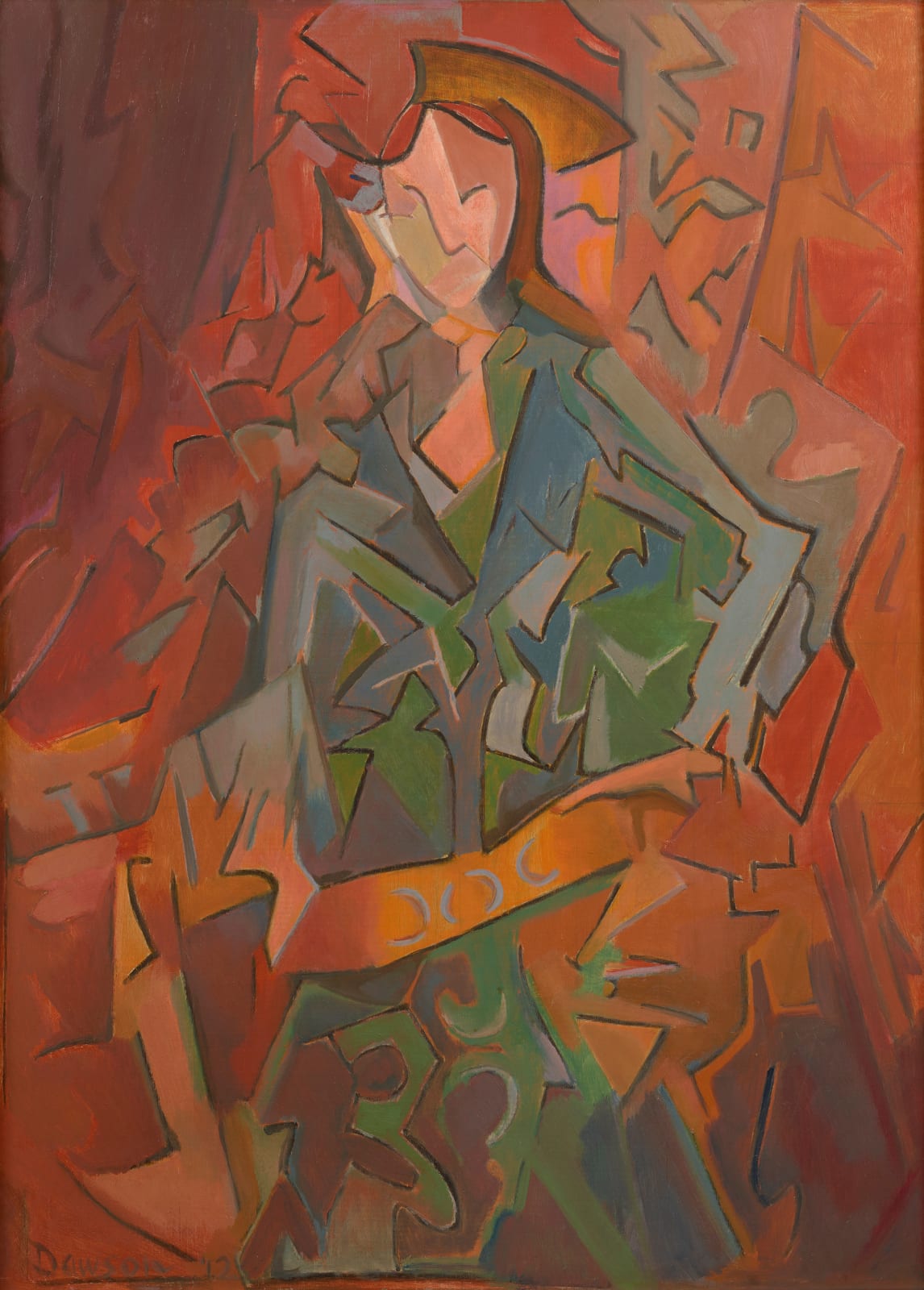Manierre Dawson American, 1887-1969
83.8 x 61 cm
In 2022, Thomas Gainsborough’s renowned painting A Portrait of a Young Gentleman—better known as Blue Boy—returned to the National Gallery in London for a landmark exhibition 100 years after it was last shown at the institution. The sale of Blue Boy in 1921 to American railroad titan Henry Huntington for $728,000 made it the most expensive painting in the world and inspired a farewell tour before its departure to Huntington in California.
Gainsborough’s celebrated 1770 portrait was first revealed at London’s Royal Academy, where the subject’s lustrous blue satin clothing shocked viewers and was met with a controversial reception. Conventional modes of expression at the time favored warm red tones. According to the Huntington Museum, Gainsborough painted “a chaos of erratic color and brushstrokes” and “Blue Boy did not seduce its first viewers with an image of a celebrity or with philosophical allusions, but with Gainsborough’s command of paint and the sheer mastery of his brushwork.”
In 1912, Manierre Dawson, one of the first Americans to paint in a non-objective style, produced a modernist reinterpretation of Gainsborough’s iconic subject. Dawson’s Blue Boy exemplifies a pivotal period of the artist’s career from 1910 to 1913, during which he painted well-known historical subjects rendered in his own personal geometric lexicon. During this creative episode, Dawson chose subjects that have become icons of the art historical canon. “Dawson’s selection of Old Masters he paraphrased was based on composition, without regard to style, subject matter, nationality, or historic period,” leading Dawson expert Dr. Randy Ploog has asserted. In Dawson’s personal record book, his Blue Boy is listed among titles such as Madonna, inspired by Leonardo da Vinci’s Virgin of the Rocks (1495–1508; National Gallery, London), and Birth of Venus, indebted to Peter Paul Rubens’ The Feast of Venus (1635–36; Kunsthistorisches Museum, Vienna).
“Time and again I have had the thought that all artists in all times past and present are trying to do the same thing, to make a picture and make it right,” Dawson wrote in 1911. By aligning himself with motifs from the Old Masters, Dawson placed the central focus on his singular style, described as “highly agitated and dynamic” in 1988 by Mark Bessire, now the director of the Portland Museum of Art. Dawson’s motivation was to use his source to create “a purely arbitrary pattern of shapes, a kind of jigsaw puzzle arrangement that disguises and camouflages the underlying form rather than revealing it,” art historian Henry Adams has observed. Yet, Blue Boy’s distinctive pose with arm akimbo and its emblematic blue tones point to its illustrious source subject.
Artistic appropriation has yielded some of the most innovative art in history. In fact, in his Blue Boy, Gainsborough borrowed from Anthony van Dyck to create attire for the young gentleman in the portrait—the so-called Van Dyck dress was named for the seventeenth-century Flemish painter who had had a major impact on British art. Since then, countless other leading figures of the art historical canon have blended inspiration drawn from previous generations with their own creative ideas to generate new approaches to making art. Édouard Manet’s celebrated Le Déjeuner sur l’herbe (1863; Musée d’Orsay), for instance, features a subject borrowed from sixteenth-century master colorist Titian. Both Pablo Picasso and Roy Lichtenstein interpreted Eugène Delacroix’s seminal Femmes d’Alger dans leur appartement (1834; Musée du Louvre). Andy Warhol created a series of works appropriating the subjects and style of Giorgio de Chirico, who also famously created copies of his own metaphysical work. Five years after Dawson’s Blue Boy was painted, Marcel Duchamp placed a urinal on its side and signed it under the pseudonym R. Mutt, borrowing from everyday life to create art.
Blue Boy continues to inspire post-war and contemporary artists and creators today, including Kehinde Wiley and Quentin Tarantino. An early abstract artist who contributed to the development of modernism when nonrepresentation was in its infancy in America, Dawson displayed an unusually early instinct to explore the act of appropriation in image-making decades before scholars, critics, and other artists began to question the unwavering importance placed on originality as authenticity.
Provenance
The artist; toEstate of the artist; to
Dr. Lewis Obi, Frank McKeown, and Lefferts Mabie, 1978; to
Private collection, 1991 until the present
Exhibitions
Grand Rapids Art Museum, Michigan, Retrospective Paintings by Manierre Dawson, April 3-24, 1966Ringling Museum of Art, Sarasota, Florida; and Norton Gallery and School of Art, West Palm Beach, Florida, Manierre Dawson: Paintings 1909-1913, November 6, 1967-February 18, 1968, no. 14
Robert Schoelkopf Gallery, New York, Manierre Dawson, April 5-May 1, 1969, no. 19
Hollis Taggart Galleries, New York, Manierre Dawson: American Pioneer of Abstract Art, October 1-30, 1999, no. 33
Swope Art Museum, Terre Haute, Indiana, Manierre Dawson: American Pioneer of Abstract Art, December 1-30, 2000
Hollis Taggart Galleries, New York, Inheriting Cubism: The Impact of Cubism on American Art, 1909-1936, November 28, 2001-January 12, 2002
Hollis Taggart Galleries, New York, Marking Modernism: A Decade with Carles, Dawson, and Maurer, October 8-November 14, 2009
Literature
Manierre Dawson, Record of paintings and sculpture, "1912: Blue Boy, 32 1/4 x 23 3/4, wood," Manierre Dawson papers, 1904-1963, Archives of American Art, Smithsonian InstitutionHollis Taggart, Vivian Bullaudy, Henry Adams and Randy J. Ploog, Manierre Dawson: American Pioneer of Abstract Art, New York: Hollis Taggart Galleries, 1999, illus. pl. 33
Robert Haas and David Lehman, The Best American Poetry, New York: Scribner, 2001, illus. on cover
Hollis Taggart, Vivian Bullaudy and Stacey B. Epstein, Inheriting Cubism: The Impact of Cubism on American Art, 1909-1936, New York: Hollis Taggart Galleries, 2001, no. 10, illus.
Randy J. Ploog and Myra Bairstow, Manierre Dawson (1887-1969): A Catalogue Raisonné, Jacksonville, Florida: The Three Graces, LLC in association with Hollis Taggart Galleries, no. 1912.10, p. 182, illus.

